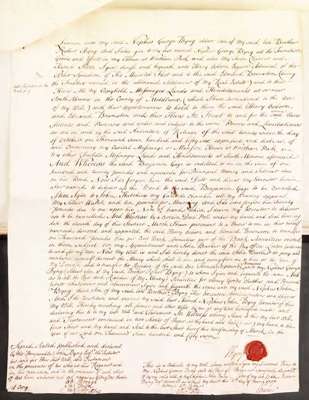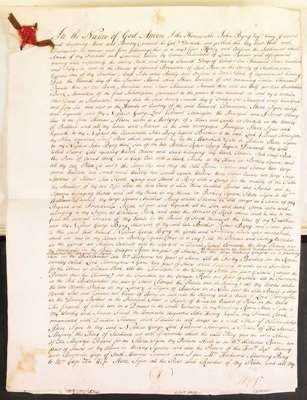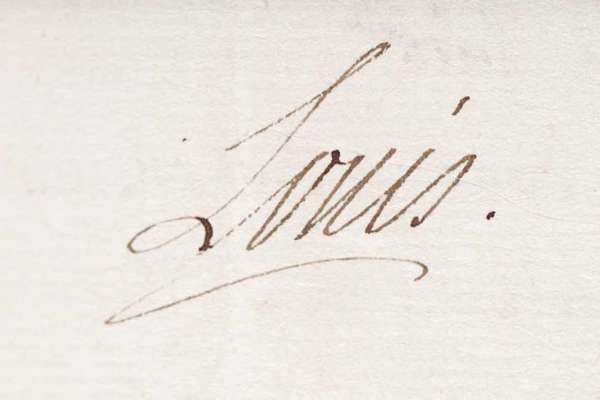
Lot 175

BYNG Admiral The Hon. John










Auction: 1 February 2005 at 11:00 GMT
Description
The trial of the Honourable Admiral John Byng at a court martial as taken by Mr. Charles Fearne, Judge-Advocate of His Majesty's Fleet: published by order of the Right Honourable the Lords Commissioners of the Admiralty at the desire of the court-martial ... 1st edition, 19th century half blue morocco, cloth boards, by Ayling, London: Manby et al., 1757
Note: The sheets of the text are mounted and the work expanded with the addition of about 180 items associated with Byng, the Admiralty, the Seven Years War, the campaigns in which Byng was involved and current events of the day. The material consists of autograph letters and other documents, engraved maps, cartoons, ballads, broadsides, pamphlets, proclamations and numerous engraved portraits of Byng and his contemporaries in the Navy and government.
Admiral Byng (1704-1757) was the fourth son of George Byng, Lord Torrington, and entered the Navy in 1718. At the onset of the Seven Years War, the island of Minorca was threatened by an attack from the French. Byng was ordered to the Mediterranean to relieve the garrison of Fort St. Philip which was still holding out. Byng had considerable misgivings about the enterprise. Before Byng could land any soldiers, the French fleet under M. de La Galissonnière appeared. Byng found himself with his leading ships positioned without the support of the rest of his line which lead to the French getting away undamaged. After waiting off Minorca for a further four days without either making any attempts to contact the fort or sighting the French, Byng sailed away to Gibraltar leaving the fort to its fate. The failure caused a savage outbursts of wrath in the country as the cartoons, songs and broadsides in the present collection illustrate. Byng was ordered home, tried by court-martial and shot at Portsmouth on the quarter deck of the Monarque on March 14, 1757.
In addition to numerous engraved portraits of himself, amongst the items most directly associated with Byng are:
[i] An autograph letter to Sir John Ackworth from the Gibraltar at Plymouth, dated 22 October 1727 and signed "Jn: Byng". 3 pages and cover. 23 x 18.5 cms. Byng had been promoted to the command of the Gibraltar frigate in the Mediterranean on 8 August 1727. In this letter, he assures Ackworth that "no ship can do better in all respects". He notes that he is to convey passengers to Lisbon, but points out that the arrangements on board for women are very poor. He states that he would be ready to sail on the Wednesday.
[ii] Autograph letter, from "Boyn Vado Bay", dated 12 July 1740, addressed to "Gentlemen" [at foot of letter] "Honble. Commissrs. of the Navy" and signed "Jn. Byng". 30 x 19 cms. The letter informs the Navy Board that Byng has drawn funds of £2,500 to pay for "contingent services of His Majestys Fleet" under his command.
[iii] A receipt, signed in two places by Byng for annuities out of the Sinking Fund, dated 21 July 1750 for £138.00 for six months annuity. 28 x 19 cms.
[iv] A copy of Byng's will on 2 folio sheets with a third folio sheet as cover. 50 x 37 cms. The will is dated 12th March 1757, 48 hours before his execution and signed by Byng at the foot of both sheets. The copy is witnessed by three signatures and sealed with Byng's seal. There is a codicil of the same date, witnessed by the same three signatures and again signed by Byng, leaving his diamond ring to his nephew George and the best of his other rings, not already disposed of in the will, to his nephew John Byng. Original folds strengthened from behind. Small tear to the lower margin of the second sheet through the signatures of the witnesses to the will and small hole in the text of the codicil with loss of a couple of letters of inscription.
[v] Autograph note from Admiral Boscawen, signed "E. Boscawen" and addressed from the Rendevoue [sic] of the Island of Scattery and dated 21 April 1755. Folded sheet, 36 x 23 cms. Written on one page and cover. As one of the Lords Commissioners, Boscawen signed Byng's instructions on 30 March 1756; signed the order for his court-martial on 14 December; and, as commander-in-chief at Portsmouth signed the immediate order for his execution on 14 March.
[vi] Ms order "By the commander for executing the Office of Lord High Admiral of Great Britain & Ireland", to Captain Graves, commander of H.M. sloop Hazard signed " Anson" and dated 12 May 1755. On 2 sides of a single sheet, 30 x 19 cms. The order instructs the sloop to proceed to sea with all possible dispatch and to cruise between Brest and Ushant to observe any French ships of war standing for Brest. Anson was at the Admiralty when Byng was promoted Admiral of the Blue and to some extent must be held accountable for Byng's going to sea "to deal with a situation which ought never to have arisen". (Tunstall Admiral Byng p. 61)
[vii] Autograph letter from the Comte de Maillebois to the Marquis de Segur, French Minister of War dated 16 February 1783. One page 20 x 15 cms. Maillebois dstinguished himself at the taking of Port Mahon.
[viii] Autograph letter by de La Galissonnière, signed "LaGalissonniere" and dated from Nantes 21 October 1753. 2 pages, 21 x 16 cms. De La Galissonnière was the commander of the fleet which outmanouevred Byng on 20 May 1756 and led to Byng abandoning the relief of the garrison of Fort St. Philip on Minorca.
[ix] A second autograph letter from De La Galissonnière, on 3 pages, signed "LaGalissonniere", dated from Versailles 26 March 1755 to Choquet, commander and secretary of the Naval Academy at Brest, 22 x 16 cms.
[x] Ms official dispatch signed by Louis XV on 2 pages with cover address to Hocquart, Intendant de Marine at Brest announcing the success of La Galissonnière over Byng, dated Compiegne, 16 July 1756. A note at the foot of page 2 Choquet who records its registration at the Marine Headquarters at Brest on 23 July.
[xi] Two receipts from Byng's father, Lord Torrington, the one dated 16 August 1697 which he signs as "G. Byng", the second 19 December 1729 which he signs as "Torrington" .
A full list of the contents of the collection is available.
Provenance: With the bookplate of A.N. Broadley who was associated with the novelist and editor Edmund Yates on The World from 1885 to Yates's death in 1894.









